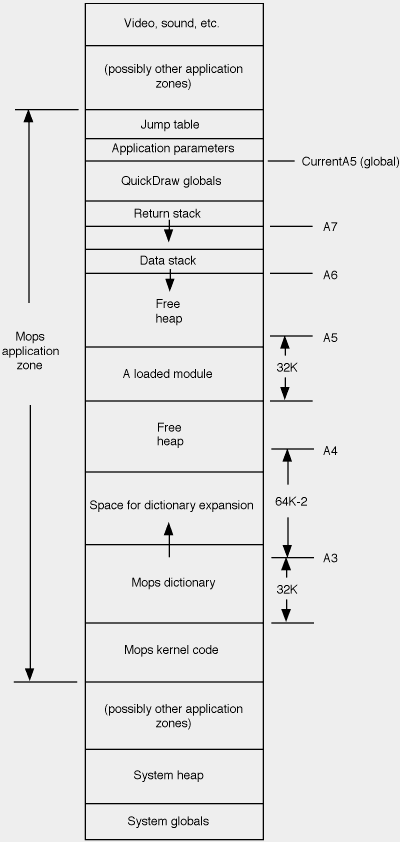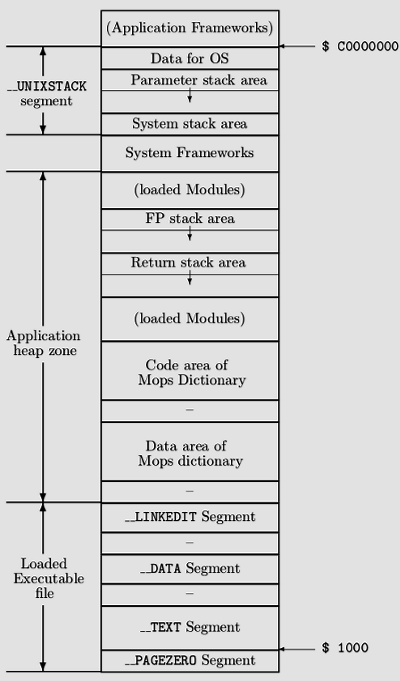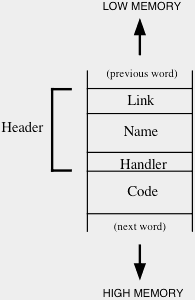Reference 5
Contents
Memory Organization
We will now move on to some of Mops' more advanced capabilities. Some of the ideas and terms we'll be describing are more fully explained in Inside Macintosh, and we'll direct you to the appropriate IM sections when necessary. Finally, if you wish to gain deeper understanding of the specialized compiling words that operate inside Mops (derived from the Forth language), we suggest you read one of several commercially available Forth texts listed in the references at the end of this chapter. Because of the way the Macintosh manages memory, Mops has several distinct areas in which it stores data. The following diagram gives a typical picture of the Mac's memory while a Mops program is running.
| Memory Map 1 (Classic Mac) |

|
| Memory Map 2 (Mac OS X) |

|
If you're new to Mac programming, don't worry about what everything in the diagram means at this stage — we'll describe the main things you need to know as we go along.
The Mops Dictionary
Near the beginning of this manual we said that a Mops program builds a dictionary of words. Each word and its definition occupies a portion of the computer's memory. A Mops definition consists of several parts, including information like whether a word is a value or a colon definition, the numbers or other data associated with the word, and machine instructions which carry out the operations specified for that word. In Mops, the areas reserved for those parts of a definition are called fields.
Most Mops words have four fields that you should be aware of:
- link field
- name field
- handler field
- code field
and they look like this in memory:
The link, name and handler fields are usually grouped together as the header field. The name field holds the actual name of the word. Its length varies with the length of the name.
The link field helps Mops programs compile quickly. In the link field is the address of an earlier word in the dictionary. This facilitates the search through the dictionary each time you type a previously defined word. The search starts at the most recently defined word (the word nearest high memory). If there is no match in the first word, the search looks to the link field for the address of the next word on which to attempt a match, and so on backward through the dictionary. The length of the name and parameter fields can change from definition to definition so there is not a fixed memory interval between words.
The content of the handler field specifies whether the word is a colon definition, a value, and so on. The handler field usually contains a negative integer, unique for each word type. When the word is compiled, the handler field is used to transfer control to the right part of the Mops compiler to compile words of this type.
For normal colon definitions, the code field contains executable code — the code that was compiled when the definition of that word was read by Mops. If you later type the word name at the keyboard, Mops looks at the handler field, sees that it is a colon definition, and transfers control to the beginning of the code field. Your compiled code is then executed. At the end of the definition, where you had put the semicolon, there is a machine language 'return' (RTS : 68k) or 'branch to link register' (blr : PowerPC) instruction. This causes control to return to the Mops interpreter.
If, instead of typing your word at the keyboard, you put it into another definition, the process is rather similar, except that instead of calling your definition directly, Mops compiles a machine language call instruction at that point, to do the calling. Then, when the later definition executes, and that call instruction is reached, your earlier definition is called.
For Mops word types other than colon definitions, the code field doesn't necessarily contain code. For example, in 68k Mops, for values and constants it contains the actual 4-byte value. In this case we call this field the 'data field', since it contains data. But it is really the same field by a different name.
The Kernel or Nucleus
In the diagram, you'll see that above some memory areas used by the Mac system is the Mops kernel code. The kernel (also known as nucleus) is the lowest, most elemental part of the Mops dictionary — that part of Mops without any predefined classes. It is what is loaded into memory when you double-click the Mops application icon itself. Saved Mops images, such as Mops.dic, appear to the Finder as documents with Mops as their owner. Therefore, when you open a saved Mops image, the Finder starts the Mops kernel as the application, and passes the name of the saved image file to the Mops kernel as a parameter (see Inside Macintosh for more detail on this). The Mops kernel then determines whether the file is a valid Mops image file, and, if so, loads it in an area of memory above the kernel. (This way of doing things is very efficient for development, since the image saved is the document you have been working on. You may save many variations of this document without changing the application itself). With PowerMops we're abandoning the idea of separate nucleus and dictionary files. This came from a time when everything had to fit on a floppies, and would have added pointless complexity to the PowerMops architecture. So now, when you do a save, you get a new application generated, which has everything in it, and you just doubleclick on that to relaunch it.
The memory area dedicated to the Mops kernel and other specifics of your program is known as the application heap, or simply the heap.
The Heap
The heap is a region of memory that can be divided into smaller sections, called blocks. When a program needs some memory temporarily, it can ask the Macintosh Memory Manager for a block of heap, and later give it back when it is done. This is what the Mops kernel does at startup in order to acquire memory for future expansion of the Mops dictionary. Mops requests a block of heap that will be large enough to allow for expansion of the user dictionary, but will leave enough room for both the system and Mops to use on a temporary basis (dynamic heap) as the program executes. Exactly how much memory is to be devoted to the dynamic heap can be altered by the Mops Install utility, which was described in Lesson 22 of the Tutorial.
Many parts of Mops and the Mac Operating System rely upon dynamic heap. For instance, when your application requires a resource, such as a font, to be loaded from disk, the Font Manager places the font in the dynamic heap. Mops modules (described below) are loaded into the dynamic heap, and any class can be told to create an object whose data exists on the dynamic heap instead of in the dictionary. Whenever you see a System Error 25, it usually means that heap has become used up or fragmented (see the Memory Manager section of Inside Macintosh). You can remedy this situation either by leaving more dynamic heap with the Install utility or by being more careful to release the heap used by your application's modules or heap objects once they are no longer needed.
The Mops dictionary can grow until it exhausts its allotted block of heap. The Mops word ROOM will return the amount in bytes of available dictionary space at any time.
Stacks
The two Mops stacks — data (parameter) and return stacks — are allocated above the application heap. Both grow downward: the return stack grows towards the base of the data stack. The Mops kernel allocates room for 1500 32-bit cells (800 64-bit cells from PowerMops 6.0) on the return stack. The data stack is limited only by the maximum address to which the heap is permitted to grow, and is allocated about 50000 in the distributed Mops system. While on Mac OS X the heap size is 4 GB (virtual) for each application. Macintosh Toolbox routines allocate their local variables on the stack, which accounts for the relatively large size of the data stack.
Various system errors can be caused by one of the stacks growing beyond its bounds. This type of error can be difficult to detect, but you should be particularly alert for return stack problems when writing recursive routines. The return stack also gets heavy use when you use a lot of named parameters and/or local variables in your methods or Mops words, since the previous values of these quantities are saved on the return stack.
The data stack is used not only by Mops, but also by the Toolbox when you invoke one of its routines. Toolbox routines allocate their local data and do parameter passing on the system stack, which is actually the same as the Mops data stack. This makes the Mops/Toolbox interface fairly easy. A Mops word need only place parameters on the data stack, just as if it were about to execute another word or method (also see the later chapter 'Calling the Toolbox').
Addresses-Relocatable and Absolute
For speed, we normally hold all addresses in the normal Mac form (which we'll call absolute since its the actual address which is directly used by the hardware). This does mean, however, that we have to do some juggling to handle addresses that are stored in the dictionary and then saved in a dictionary image which is reloaded later. In general, these addresses won't be valid any longer, since the program may well be located at a different place in memory.
For this kind of operation we have defined a relocatable address format, and the words @abs and reloc! to respectively fetch and store a relocatable address with conversion to/from absolute. We have also provided two classes, DicAddr and X-Addr which use the relocatable format internally. (DicAddr is for addresses of data, and X-Addr for executable word addresses.) These have access methods that incorporate the conversion. You should always use one of these mechanisms for accessing relocatable addresses. Don't rely on any details of the relocatable address itself, as this may change at any stage in the future, and probably will. It will stay at the same size as a stack cell, but we make no other guarantees.
Note that relocatable conversion does not need to be done nearly as often as @, w@ or c@, so that we really do gain by standardizing on absolute addresses.
Handles and Pointers
Handles and pointers are fundamental to programming on the Mac, relying as it does on dynamic allocation and reallocation of memory for flexibility. When you allocate a block of memory in the heap, you can ask for either a Handle or a Pointer. A pointer points directly at the memory you allocated (i.e. it contains the address of that block of memory), while a handle points at what is called a Master Pointer, which is what actually points to the memory. See the Memory Manager chapter of Inside Macintosh for more details on handles and pointers. Briefly, using a handle allows the Memory Manager to move the block of memory around, and thus allow memory to be used more efficiently. When the Memory Manager moves a block of memory, it updates the master pointer so that programs can still know where the block of memory is, since the program knows the address of the master pointer, and that doesn’t change. However, blocks accessed via a pointer can't be moved, since the Memory Manager has no way of knowing where the pointer (or any copies of it) are located”the program may have put them anywhere.
In Mops, we used to encourage the use of handles rather than pointers, since the ability of handle-based blocks of memory to move around made memory allocation in a small memory space easier. But today’s machines have so much memory that the extra housekeeping associated with handles is usually not worth the trouble — this is why the new Reference feature uses pointer-based blocks of memory.
Both handles and pointers are objects, with appropriate methods defined for them. If you want to do a number of operations quickly on a block of memory allocated via a handle, you may lock it in memory so the Memory Manager won't move it while you are accessing it. You may then retrieve the actual address of the block, and know that it will remain valid until you unlock the block. The methods lock: and unlock: of class Handle perform this function.
An accidental clobbering of a handle or pointer can produce a bug that can have very nasty and generally unrepeatable results, and be very hard to track down. Making them objects helps discourage doing dangerous things with them, and also allows a degree of error checking. An unallocated handle or pointer object is given a value which should always cause a trap if it is used as an address. (The actual values we use in 68k Mops are $ FFA00101 for unallocated handles, and $ FFA00103 for unallocated pointers. These two values are defined as constants with the names NilH and NilP respectively). These are illegal addresses on all Macs, as far as I am aware, and give an illegal address error if used.
As we have seen, you may define objects which are created in memory allocated on the heap, with a reference or a pointer or a handle pointing to them (see the sections above). String variables (String, String+, Bytestring) are based on Handles, and are therefore able to grow and shrink as required, since the memory they occupy is allocated dynamically.
| Reference 4 | Reference | Reference 6 |
| Documentation | ||
